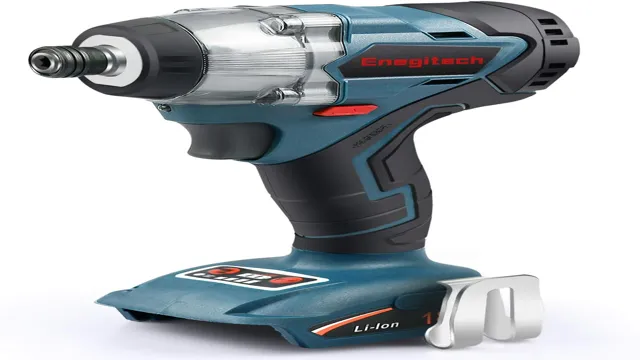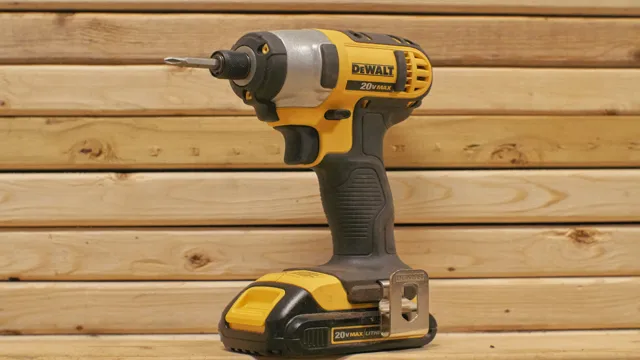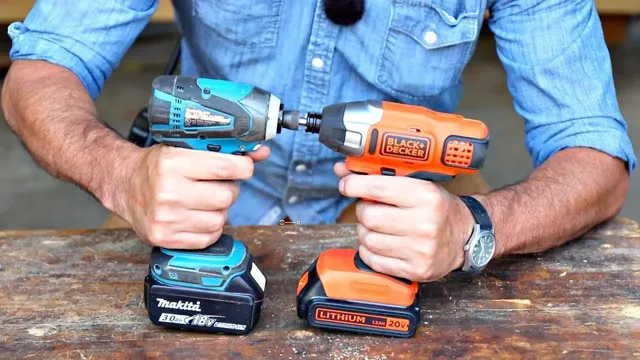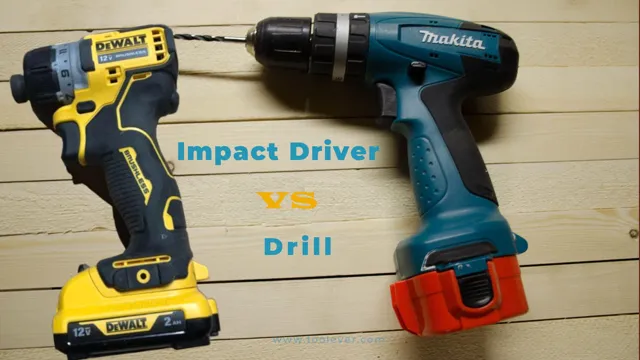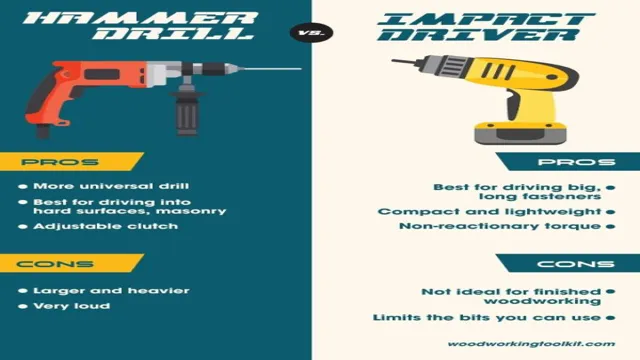Can You Use an Impact Driver to Drill Holes? Learn the Pros and Cons

Are you looking for a faster way to drill holes in your wood or metal projects? Have you considered using an impact driver? While most people associate impact drivers with driving screws and bolts, these handy tools can also be used to drill holes. In fact, an impact driver can drill holes much quicker than a traditional drill, making it a great option for DIY enthusiasts and construction professionals alike. So, how exactly do you use an impact driver to drill holes? Let’s dive in and find out!
Understanding Impact Drivers vs. Drills
If you’re wondering whether you can use an impact driver to drill holes, the answer is yes! Although impact drivers are primarily designed for fastening screws and nuts, they can also be used for drilling holes into softer materials like wood, plastic, and drywall. However, when it comes to drilling holes into harder materials like metal or concrete, an impact driver may not be the best tool for the job. The reason for this is that impact drivers exert a lot of torque but lack the speed required for drilling tasks.
This means that they can be quite slow and inefficient at drilling holes, especially if you need to make a lot of them. For this reason, it’s usually best to use a drill for drilling holes and an impact driver for fastening tasks.
Key differences between impact drivers and drills
Impact drivers and drills both look similar, but there are some key differences that sets them apart. The most significant difference is the force at which they operate. Drills use rotational force to drill screws into walls, while impact drivers use a combination of rotational and concussive force to drive in screws.
This makes impact drivers more powerful and efficient in working with tough materials. Additionally, impact drivers have higher torque, which means they can exert more force on the screw, making it less likely to slip or strip. In contrast, drills have higher speeds and are more precise, making them ideal for creating small holes in softer materials like wood and drywall.
Another key difference is the bit shank, which is thicker on impact drivers to withstand the stronger force, while the drill shank is thinner for accuracy. Impact drivers are also generally smaller and more compact than drills, making them easier to use in tight spaces. When deciding between the two, consider what kind of projects you will be working on to determine which will suit your needs best.

Pros and cons of using impact drivers for drilling
When it comes to home improvement projects, having the right tools is essential to getting the job done efficiently. One of the debates in the tool world is whether to use an impact driver or a drill for various tasks. Before delving into the pros and cons, it’s important to understand the difference between the two.
Impact drivers produce a high torque force that is best suited for driving large screws and bolts, while drills are better for drilling holes and light-duty screwing. The advantage of using an impact driver for drilling is that they are able to drill into tough materials with ease, such as concrete and hardwoods. Plus, they have an impact mechanism that reduces the strain on users’ wrists and hands.
On the other hand, drills often have a clutch which helps prevent over-tightening of screws and can drill small holes with greater accuracy. However, drills are not as effective at drilling large holes as impact drivers. Ultimately, it comes down to the task, so it’s worthwhile to have both tools on hand.
What Types of Holes Can You Drill with an Impact Driver?
If you’re wondering whether or not you can use an impact driver to drill holes, the answer is yes! Impact drivers are versatile tools that can handle a variety of drilling tasks with ease. With the right drill bits and technique, you can drill clean, precise holes in a range of materials, from wood and metal to concrete and masonry. Depending on the size and type of hole you need, you may want to choose a specific type of drill bit, such as a spade bit for large holes or a twist bit for smaller ones.
Just make sure to select a bit that’s compatible with your impact driver’s chuck size, and always wear eye protection and other safety gear while drilling. With a little practice, you’ll be able to tackle all kinds of drilling projects with your trusty impact driver.
Examples of materials and hole sizes that an impact driver can handle
When it comes to drilling holes with an impact driver, the range of sizes and types of materials that can be handled is impressive. Impact drivers are designed to provide fast, powerful bursts of force, which makes them ideal for drilling through a wide range of surfaces, from wood and plastic to metal and concrete. Depending on the size of the chuck and the power of the driver, holes with diameters of anywhere from 1/4 inch to 1-1/2 inches can be drilled with ease.
The key is to use the right type of bit for the job, such as twist bits for wood and plastic, masonry bits for concrete and stone, and cobalt bits for metal. When it comes to drilling holes in metal, an impact driver can handle a range of hole sizes, from small pilot holes up to holes that are several inches in diameter. The key is to use a drill bit that is designed for the specific type of metal you are drilling, and to use the right cutting speed and pressure to ensure a clean, accurate hole.
In summary, impact drivers are versatile tools that can handle a wide range of drilling tasks, from small pilot holes to large holes in tough materials like metal and concrete. With the right bit and a little bit of know-how, an impact driver can make quick work of even the toughest drilling jobs. So, next time you need to drill a hole, consider reaching for an impact driver – you might be surprised at what it can handle!
When to opt for a traditional drill instead of an impact driver
An impact driver is a powerful tool that can handle a lot of tough drilling jobs, but there are certain types of holes that you’ll want to use a traditional drill for instead. For example, if you need to drill holes in wood that are larger than 1/2 inch in diameter, you’ll want to use a drill with a spade bit instead of an impact driver. Spade bits are designed specifically for larger holes and will produce cleaner, more precise results than an impact driver.
Additionally, if you’re working with masonry or concrete, you’ll want to use a hammer drill instead of an impact driver. Hammer drills use a forward and backward motion that allows them to break up tough materials and create holes without damaging the bit. So, while an impact driver is a great tool for most drilling jobs, it’s important to know when to switch to a traditional drill to get the best results.
How to Drill Holes with an Impact Driver
Yes, you can use an impact driver to drill holes. However, it’s important to carefully select the right drill bit or driver accessory to avoid damaging the drill and to ensure your safety. Not all impact drivers are created equal, and some may not be suitable for drilling certain materials.
To start, make sure you have the right drill bit for the job – using a bit designed for standard drills may cause it to overheat and the edges to dull quickly. Impact-rated bits are made from stronger materials and can withstand the high torque and vibration produced by impact drivers. Additionally, it’s important to adjust the drill’s speed and torque settings to match the material and the size of the bit.
Using the wrong settings can cause the bit to break or the drill to strip its gears. With the right preparation and technique, an impact driver can be an efficient and effective way to drill holes in wood, steel, masonry, and other materials.
Step-by-step guide for drilling holes with an impact driver
If you’re looking to drill holes quickly and easily, an impact driver can certainly help. To begin, choose the right type of bit for your project, whether it’s for wood, metal, or concrete. Next, insert it into the chuck and secure it tightly.
Then, adjust the torque settings on your impact driver based on the size and depth of the hole you need to drill. As you begin, hold the driver with a firm grip and position it at a 90-degree angle to the surface you’re drilling into. Apply steady pressure as you drill, allowing the impact driver’s powerful motor to drive the bit through the material.
Be sure to periodically remove the bit and clear away any debris to ensure a clean hole. With these simple steps, you’ll be able to drill holes easily and efficiently with an impact driver!
Tips for ensuring accuracy and safety while using an impact driver
Impact driver If you’re looking to drill holes with an impact driver, there are a few things you should keep in mind to ensure accuracy and safety. First, choose the right size drill bit for the job – a bit that’s too small won’t create the hole you need, while a bit that’s too large could damage your workpiece or the drill itself. Once you have the right bit, make sure to secure it properly in the chuck of the impact driver.
A loose bit could wobble and create an uneven or oversized hole. When you’re ready to start drilling, hold the impact driver steady and perpendicular to the workpiece. The impact driver’s high torque can cause it to twist in your hand if you’re not careful, so it’s important to maintain firm control.
As you drill, apply gentle pressure and let the impact driver’s mechanism do most of the work – trying to force the bit through the material could damage both the driver and your workpiece. Finally, be sure to wear appropriate safety gear while drilling. Eye and ear protection are essential, as impact drivers can generate a lot of noise and debris.
If you’re using your impact driver for an extended period of time, you may also want to consider wearing gloves to prevent blisters or calluses from forming on your hands. By following these tips, you can use your impact driver to drill holes quickly and efficiently, while keeping yourself and your workpiece safe from harm.
Conclusion
In conclusion, while an impact driver may technically be able to drill holes, it’s like using a hammer to unscrew a bolt – sure, it may work in a pinch, but it’s not the best tool for the job. If you want to take the hassle out of drilling holes, invest in a good quality drill and save your impact driver for those tough fastening jobs it was designed for. Trust us, your hands (and your sanity) will thank you in the long run.
“
FAQs
What is an impact driver and how does it differ from a drill for drilling holes?
An impact driver is a power tool that delivers high torque output with minimal effort, making it great for driving long screws or bolts. However, it might not be the best for drilling holes as it lacks the control and precision of a drill.
Can an impact driver be used for drilling holes in wood, metal, or masonry?
An impact driver can be used for drilling holes in softer materials like wood, but it’s not recommended for drilling holes in metal or masonry. Instead, a drill with the appropriate bit should be used for these materials.
What kind of drill bit should be used with an impact driver for drilling holes?
It’s best to use a hex-shank drill bit with an impact driver for drilling holes. These bits have a hexagonal shank that fits snugly into the quick-change chuck of the impact driver.
Is an impact driver more powerful than a drill for drilling holes?
While an impact driver can deliver higher torque output than a drill, it might not be the best tool for drilling holes. A drill has more control and precision, making it better for creating accurate holes.
How can I safely use an impact driver to drill holes?
To safely use an impact driver for drilling holes, always wear eye protection and work gloves. Start the hole with a small pilot bit, and then gradually increase the bit size until you reach the desired diameter. Use light pressure and let the tool do the work to avoid causing damage or injuring yourself.



